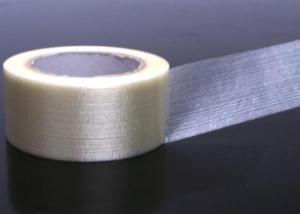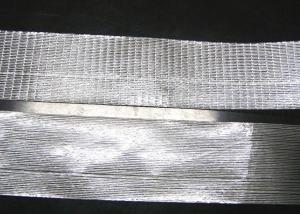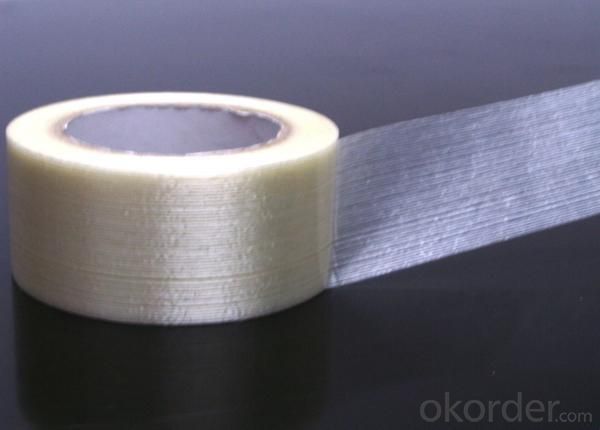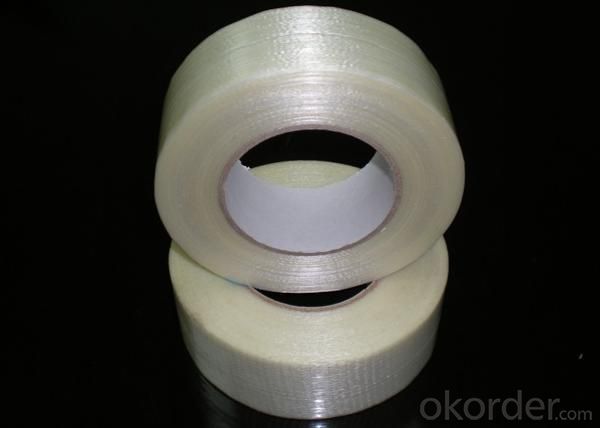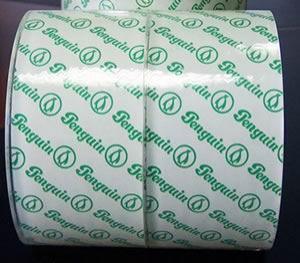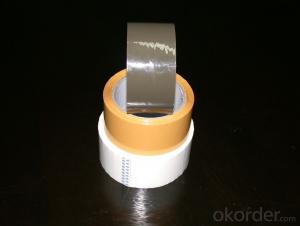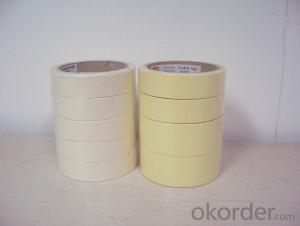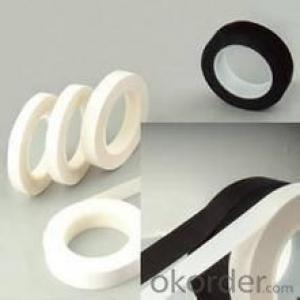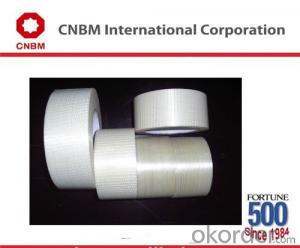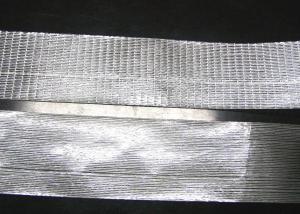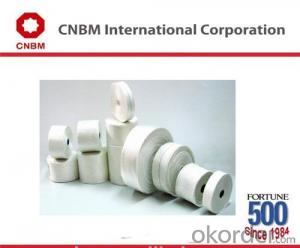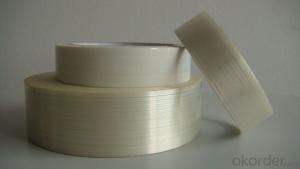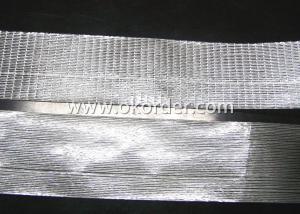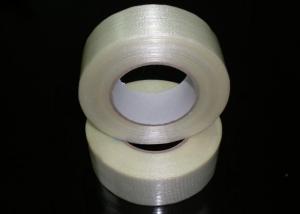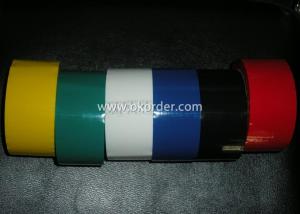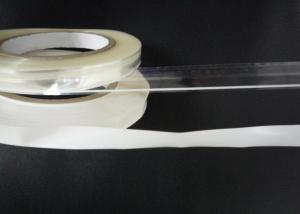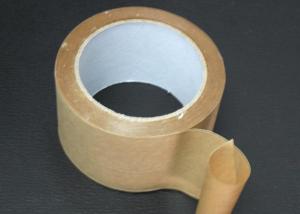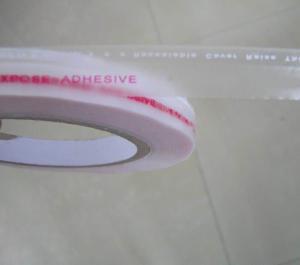Designer Scotch Packaging Tape - China Fiberglass Tape FGT-140
- Loading Port:
- China Main Port
- Payment Terms:
- TT or L/C
- Min Order Qty:
- USD3000 roll
- Supply Capability:
- 30 Days For 1x20' FCL roll/month
OKorder Service Pledge
OKorder Financial Service
You Might Also Like
Quick Details Of China Fiberglass Tape FGT-140:
1. Filament / fiberglass tape is with PET film and one-directional fiberglass.
2. The tape is with high tensile strength, used for palletizing, holding, bundling, reinforcing, heavy duty packing, carton packing & sealing.
3. Standard cut roll packing: one roll per plastic bag, then into cartons. We can also offer special packing as per customer's requirements, such as label, core printing and sticker.
CONSTRUCTION Of China Fiberglass Tape FGT-140:
Backing: One directional Fiberglass + PET film
Adhesive: Hot melt rubber based adhesive
TYPICAL PHYSICAL PROPERTIES Of China Fiberglass Tape FGT-140:
Total Thickness (adhesives + backing): 140micron
Initial Tack: more than 18# steel ball
Tensile Strength: more than 180N/25mm
Peel Adhesion: 13 N/25mm
Holding power: not less than 30h (1kg/25mm)
Temperature resistance: 60C
Elongation: 0.3%
Sizes Of China Fiberglass Tape FGT-140:
Jumbo Roll: 1.02 x 1000m
Cut Roll: As per customer's requirements
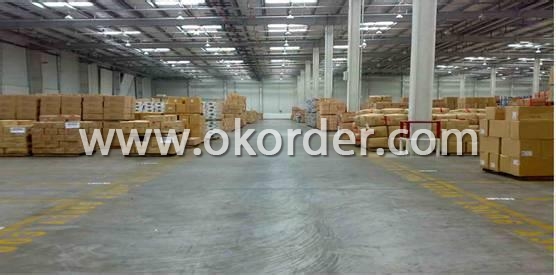
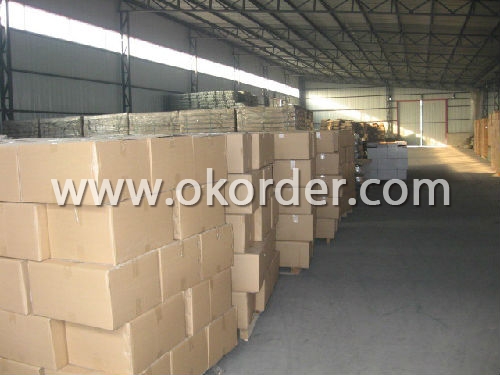
- Q: Can packaging tape be used for sealing plastic toys?
- Yes, packaging tape can be used for sealing plastic toys. Packaging tape is designed to be strong and adhesive, making it ideal for securing and sealing various types of materials, including plastic. It can effectively hold together the different parts of a plastic toy and provide a secure seal, ensuring that the toy remains intact. However, it is important to note that packaging tape may not be as aesthetically pleasing as other specialized tapes designed specifically for toy packaging, such as clear tape or decorative washi tape.
- Q: How does packaging tape perform on oily or greasy surfaces?
- Packaging tape typically struggles to perform well on surfaces that are oily or greasy. The adhesive on packaging tape is specifically designed to stick to surfaces that are clean and dry. Therefore, when applied to surfaces that are oily or greasy, the tape may have difficulty sticking securely. The presence of oil or grease acts as a barrier, preventing the adhesive from effectively bonding with the surface. Consequently, there is a greater likelihood of the tape peeling or coming loose. To ensure proper adhesion on surfaces that are oily or greasy, it is advisable to clean and degrease the surface thoroughly before applying packaging tape. Using a degreasing agent or detergent can assist in eliminating the oil or grease, thereby enabling the tape to adhere more effectively. In addition, opting for a high-quality packaging tape that possesses a strong adhesive can also help overcome the challenges posed by oily or greasy surfaces.
- Q: Can packaging tape be used for sealing glass bottles?
- Yes, packaging tape can be used for sealing glass bottles. However, it is important to note that it may not provide the same level of security and protection as specialized bottle sealing methods such as corking or using bottle caps. Packaging tape may not be as effective in preventing leakage or maintaining the freshness of the contents.
- Q: Can packaging tape be used for sealing glass jars?
- Indeed, sealing glass jars is possible with packaging tape. However, it should be noted that packaging tape is not specifically designed for this purpose and more suitable alternatives are available. While packaging tape can offer a temporary seal, it may not be as effective in preserving the freshness and airtightness of the jar's contents. Furthermore, the tape may not adhere well to glass surfaces and could peel off over time, potentially compromising the seal. For optimal results in preserving the contents of glass jars, it is recommended to utilize specialized methods and materials such as rubber gaskets, metal lids with screw caps, or heat-sealing techniques.
- Q: Can packaging tape be used for sealing plastic bags?
- Indeed, sealing plastic bags can be accomplished with the utilization of packaging tape. Designed with robust adhesive properties, packaging tape can effectively secure various items, including plastic bags. To achieve a secure seal and prevent spillage or exposure to air and moisture, the tape can be applied either along the opening or across the entire width of the bag. It is worth mentioning, though, that while packaging tape can serve the purpose, it may not be as efficient as specialized plastic bag sealing techniques like heat sealing or ziplock closures, which are specifically engineered for this particular task.
- Q: How does packaging tape perform when exposed to sunlight?
- Packaging tape typically performs well when exposed to sunlight, especially if it is made from durable materials like acrylic or polypropylene. These tapes are designed to resist UV rays and maintain their adhesive properties even when exposed to sunlight for extended periods. However, it is always recommended to check the specifications of the specific tape you are using, as some may have limitations or may be prone to deterioration or discoloration when exposed to direct sunlight for prolonged periods.
- Q: Selection of tapes
- For colored tapes, how to distinguish between good and bad? For the colored adhesive tape, it is usually yellow and khaki. Will be sticky, pinched, and then quickly opened, you can pull one side of the adhesive off, you can see the purity and transparency of the original film. You can also look at the thickness of the glue. If no glue is pulled or pulled apart, there's a lot of impurities in it, and the glue has no cohesion. Two is too much moisture, has been volatile, at this time, the tape has already dropped a lot of adhesive force, feel can distinguish. In fact, there are many ways to distinguish between good and bad tape, as long as the life of more attention, you can distinguish between good and bad adhesive tape.
- Q: Can packaging tape be used for sealing pet supplies or accessories?
- Yes, packaging tape can certainly be used for sealing pet supplies or accessories. It provides a strong and secure seal that can keep the contents of the packaging safe and protected. Whether you need to seal pet food bags, pet toy packaging, or any other pet-related items, packaging tape can be an effective solution. It is easy to use, durable, and readily available in various sizes and strengths. Just make sure to choose a tape that is appropriate for the specific weight and size of the package you are sealing, to ensure proper protection.
- Q: Is packaging tape safe to use on delicate items?
- The safety of using packaging tape on delicate items varies depending on the type of tape and how it is applied. Certain packaging tapes are specifically made for delicate items, minimizing the risk of damage through features like low tack adhesive or gentle release properties. These tapes, commonly known as "low-tack" or "gentle" tapes, are often transparent. When using packaging tape on delicate items, it is crucial to apply it carefully and securely, avoiding excessive force or pressure. It is recommended to test the tape on a small, inconspicuous area of the item first to ensure it does not cause harm or leave residue. Moreover, it is advisable to wrap delicate items with protective materials like bubble wrap or tissue paper before applying the tape. This extra layer of cushioning and protection can be beneficial. If you are uncertain about the safety of using packaging tape on a specific delicate item, it is always best to consult with the manufacturer or seek professional advice. They can provide guidance on the most suitable packaging materials and methods to ensure the safety of your delicate items during transit or storage.
- Q: Are there any safety precautions to consider when using packaging tape?
- Yes, there are a few safety precautions to consider when using packaging tape. First, always use caution when handling the tape dispenser to avoid accidental cuts or injuries. Ensure that the area where you are using the tape is clear of any obstacles or potential tripping hazards. It is also important to store the tape in a safe place, away from heat sources or direct sunlight, as excessive heat can cause the tape to lose its adhesive properties. Lastly, be mindful of the weight and size of the package you are sealing, as using insufficient tape can cause the package to come apart during transportation.
1. Manufacturer Overview
| Location | Dongguan, China |
| Year Established | 2011 |
| Annual Output Value | Above US$ 5 Million |
| Main Markets | 30.00% North America 10.00% South America 20.00% Eastern Europe 20.00% Northern Europe 10.00% Western Europe 10.00% Africa |
| Company Certifications | ISO 9001:2008 |
2. Manufacturer Certificates
| a) Certification Name | |
| Range | |
| Reference | |
| Validity Period |
3. Manufacturer Capability
| a) Trade Capacity | |
| Nearest Port | Guangzhou Port |
| Export Percentage | 10% - 20% |
| No.of Employees in Trade Department | 3-5 People |
| Language Spoken: | English; Chinese; |
| b) Factory Information | |
| Factory Size: | Above 1000 square meters |
| No. of Production Lines | Above 10 |
| Contract Manufacturing | bopp tape, PE foam tape, EVA foam tape, cloth tape, masking tape, PET tape, kraft paper tape |
| Product Price Range | High; Average |
Send your message to us
Designer Scotch Packaging Tape - China Fiberglass Tape FGT-140
- Loading Port:
- China Main Port
- Payment Terms:
- TT or L/C
- Min Order Qty:
- USD3000 roll
- Supply Capability:
- 30 Days For 1x20' FCL roll/month
OKorder Service Pledge
OKorder Financial Service
Similar products
Hot products
Hot Searches
Related keywords
